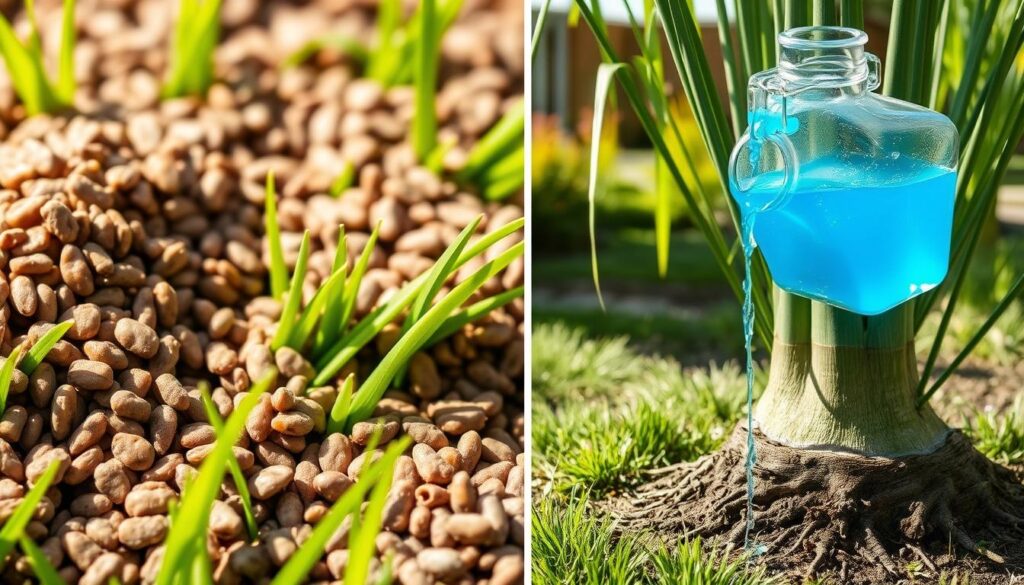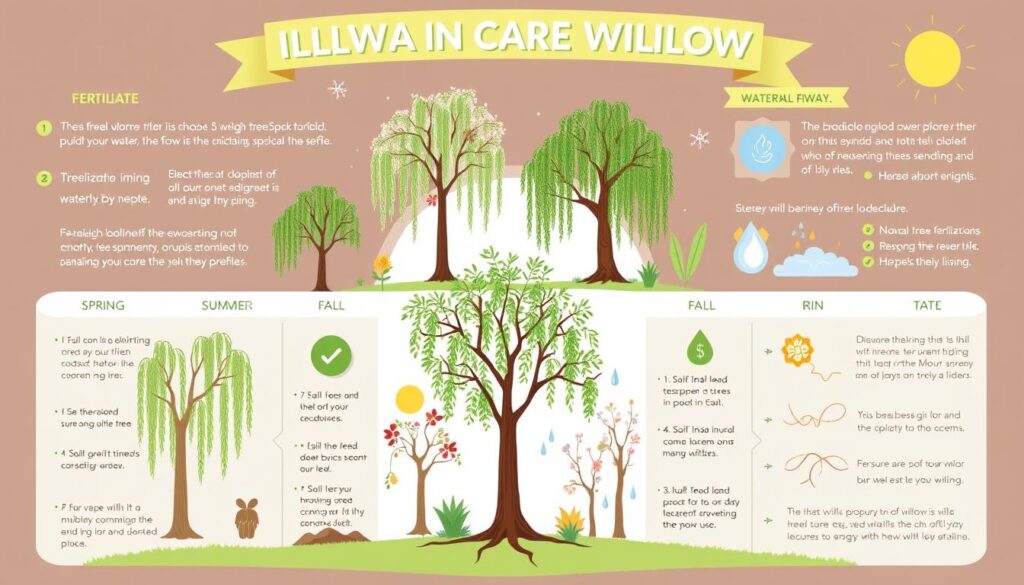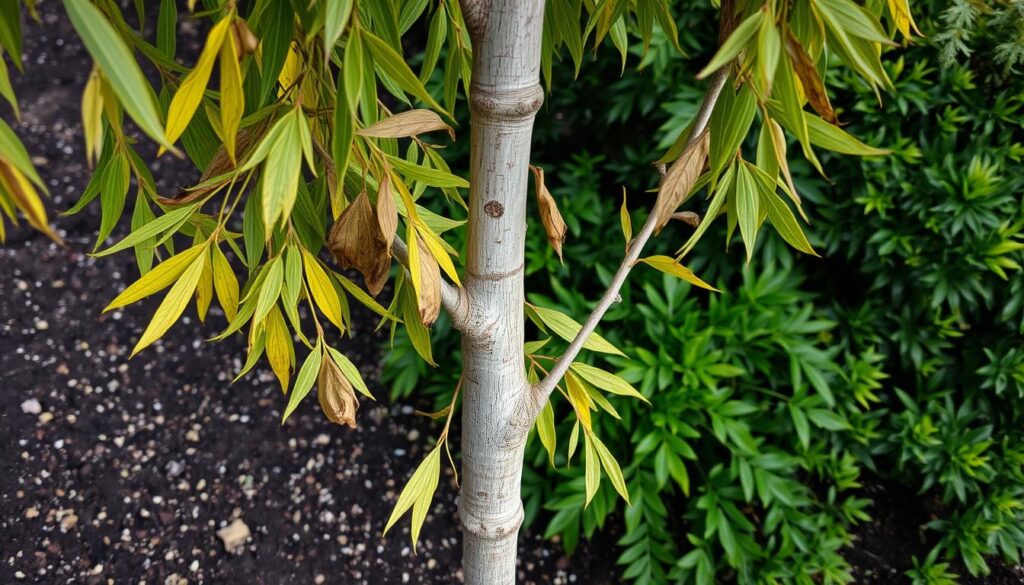Willow trees add beauty to any garden with their elegant branches and lush leaves. But, they need the right food to stay healthy and grow well. Knowing what willows need and picking the best fertilizer is important for vibrant trees.
Willow trees can be small or very tall, growing from 3 to 50 feet. They do best in zones 2 through 8. They like slightly acidic to neutral soil and can live up to 50 years. Giving them the right nutrients is key to their health and beauty.
For big trees like weeping willows, the right fertilizer is vital. They grow fast, up to 4 feet a year. Even small weeping willows in pots need good food, as their soil gets washed away by water.
Table of Contents
Key Takeaways
- Willow trees can grow from 3 to 50 feet in height and thrive in USDA zones 2 through 8.
- Optimal soil pH for willows is between 5.5 and 7.
- Weeping willows have a lifespan of up to 50 years and can grow up to 4 feet per year.
- Proper fertilization is vital for willow tree health and beauty.
- Dwarf weeping willow trees in containers need fertilization due to frequent watering.
Understanding the Nutritional Needs of Willow Trees
Willow trees need a balanced diet of nutrients to grow well. They can grow up to 45 feet tall. This requires a steady supply of nutrients for their health and growth.
The Importance of Nitrogen
Nitrogen is key for willow trees, helping them grow leaves. It’s used a lot for leaf growth and photosynthesis. A nitrogen-rich fertilizer helps them grow faster, adding up to 10 feet a year.
Phosphorus and Potassium: Key Minerals
Phosphorus and potassium are important for willows. They help with root health and tree stability. Phosphorus helps roots grow strong, while potassium fights diseases and moves nutrients well.
Micronutrients: Essential for Growth
Micronutrients like iron, manganese, and zinc are needed in small amounts. They help with many tree functions, like making chlorophyll. Iron, for example, stops leaves from turning yellow. A balanced fertilizer with these nutrients supports healthy growth.
Best Types of Fertilizer for Willow Trees
Choosing the right fertilizer for willow trees is key. It affects how well nutrients reach the tree. We’ll look at granular, liquid, and organic fertilizers. Each has a special role in caring for willow trees.
Granular Fertilizers
Granular fertilizers slowly release nutrients. They keep the tree fed over time. They’re great for keeping nutrient levels up, even in summer.
Use 2 pounds of granular fertilizer for every inch of trunk diameter. Spread it around the tree’s drip line. Then, water well to help it soak in.

Liquid Fertilizers
Liquid fertilizers give a quick nutrient boost. They’re best when willow trees need fast help. Apply them three to four times a year, from late April to mid-July.
A 20-20-20 mix is often suggested. It has balanced nitrogen, phosphorus, and potassium. These are all important for willow tree health.
Organic Options
Organic fertilizers are great for those who care about the environment. Options like compost, aged manure, or Espoma Tree-Tone Organic Fertilizer (6-3-2) are good. They feed the tree and improve soil health.
Use one bushel of organic fertilizer for every inch of trunk caliper. This method supports long-term tree health and protects the environment.
When to Apply Willow Tree Fertilizer
Knowing when to fertilize willows is key for their growth. It’s part of a good willow tree care schedule. This helps them grow strong and healthy.
Best Seasons for Fertilization
Finding the best times to fertilize willows is important. Early spring is a great time because trees are waking up. Fertilizing then gives them energy for new growth.
Prune willow shrubs in early spring too. Do it just before leaves come out.
In summer, give trees more nutrients when they bloom. This helps them grow well. Fertilize again in autumn to get them ready for winter.

Frequency of Application
How often to fertilize depends on the tree’s needs. Young White Willows need balanced liquid fertilizer every 4-6 weeks in spring and summer. This helps them absorb nutrients well.
Older White Willows need fertilizer once a year in spring. Use granulated fertilizer at 2 pounds or 2 pints per 100 square feet. Fertilize monthly in summer for better growth. More nitrogen in summer helps leaves grow lush.
Use organic fertilizers like manure for young trees. Apply one bushel per 6-foot shrub or 100 square feet. Liquid fertilizers should be used three to four times a year, from late April to mid-July. This keeps nutrients steady.
How to Identify Nutrient Deficiencies
It’s important to spot and fix nutrient deficiencies in willows to keep them healthy. Knowing the signs helps gardeners take action quickly. This ensures their willow trees stay strong and colorful.

Yellowing Leaves: A Sign
Yellow leaves are a clear sign of nutrient problems in willows. This often means they need more nitrogen or iron. For example, too little nitrogen makes leaves pale yellow from the bottom up.
Iron deficiency makes young leaves yellow, but the veins stay green. Testing the soil regularly helps find these issues. This way, gardeners can use the right fertilizers to fix the problem.
Stunted Growth Concerns
Stunted growth is another warning sign for willow trees. It can be due to not enough phosphorus or potassium. Phosphorus helps with energy and root growth, while potassium boosts growth and fights diseases.
To fix stunted growth, using a balanced fertilizer like 10-10-10 is helpful. Also, make sure to water them right and avoid too much fertilizer. Willows need steady moisture to grow well.
Top Willow Tree Fertilizer Brands
Choosing the right fertilizer brand is key to your willow trees’ health and beauty. We’ve looked at top willow tree fertilizers based on what people say. This helps you choose the best for your garden.
Brand A: Overview and Benefits
Jobe’s Tree And Shrubs Fertilizer Spikes (15-3-3) work well for many trees, including willows. They give nutrients right to the roots, helping trees grow strong. The 16-4-4 formula is great for young trees, helping them grow well and is easy to use.
Brand B: Customer Feedback
Miracle-Gro Tree And Shrub Plant Food Spikes get high praise for boosting tree health. With a 15-5-10 N-P-K formula, they’re perfect for spring and fall. People notice better leaf color and tree health.
Brand C: Recommended Uses
Espoma Tree-Tone Organic Tree Fertilizer (6-3-2) is a top pick for its organic nature. It’s great for willows and other trees like apples and cherries. Gardeners love it for being good for the environment and improving soil health, leading to healthier trees.
| Brand | N-P-K Ratio | Recommended Use | Key Benefits |
|---|---|---|---|
| Jobe’s | 15-3-3 | Young Trees | Direct root zone application, consistent nutrient delivery |
| Miracle-Gro | 15-5-10 | Spring and Fall Application | Improved tree health, convenient application |
| Espoma | 6-3-2 | Organic Fertilization | Enhances soil health, environmentally friendly |
DIY Willow Tree Fertilizer Solutions
Creating homemade willow fertilizer is a great choice for eco-friendly gardeners. Compost and coffee grounds are excellent options. They make the soil rich in nutrients, helping willow trees grow well.
Compost as a Natural Fertilizer
Compost is made from organic matter and is full of nutrients. It improves soil structure and boosts plant health.
- Nutrient-Rich: Compost has all the nutrients willows need to grow.
- Soil Improvement: It makes soil better for water and roots.
- Eco-Friendly: Composting is good for the planet, reducing waste.
Coffee Grounds: Benefits and Uses
Coffee grounds are great for plants, including willows. They offer many benefits:
- Nitrogen-Boosting: Coffee grounds add nitrogen, helping leaves grow.
- pH Adjustment: They can make alkaline soils more acidic, better for willows.
- Soil Health: Coffee grounds help break down organic matter, making soil richer.
To get the most from your homemade fertilizer, use both compost and coffee grounds. Mix them into your soil:
| Ingredient | Benefits | Application Method |
|---|---|---|
| Compost | Improves soil health, structure, and nutrient levels. | Mix into soil at planting or as a top-dress in the spring and fall. |
| Coffee Grounds | Increases nitrogen, improves soil acidity, and boosts microbial activity. | Sprinkle around the base of willow trees or mix with compost before application. |
Best Practices for Fertilizing Willow Trees
To fertilize willows right, you need to know how to apply the fertilizer and water them well after. This helps the nutrients get absorbed by the tree.
Proper Application Techniques
For granular fertilizers, use 2 lbs or 2 pints for every 100 square feet of soil. If you’re drilling holes, put 2 pounds of fertilizer for every inch of trunk diameter in several holes. This spreads the nutrients evenly around the roots.
Liquid fertilizers, like Miracle Gro, should be applied 3 to 4 times a year. Start in late April and stop by mid-July. A mix with more nitrogen, like 20-20-20, is great for young trees. It helps them grow fast.
For organic fertilizers, use compost or a bushel for every inch of trunk diameter. Coffee grounds are also good for nitrogen, which is key for these trees.
Watering After Fertilization
After fertilizing, it’s important to water your willows well. For granular fertilizers, a deep watering helps the granules dissolve and feed the roots. Liquid fertilizers are already soluble, but watering regularly is key to prevent nutrients from washing away.
In dry times, water your willows deeply but slowly a few times a week. This keeps the soil moist and helps the tree absorb nutrients better. This keeps your willow tree healthy and green.
Following these tips on how to fertilize willows and watering them right will make your trees grow strong and look great.
Environmental Considerations for Fertilizing
Fertilizing willow trees needs careful thought about the environment. Eco-friendly gardening and cutting down on fertilizer runoff are key. These steps help keep plants and the ecosystem safe from pollution.
Minimizing Runoff and Pollution
Slow-release fertilizers are a smart choice to cut down on runoff and pollution. They give nutrients slowly, so less goes into waterways. For example, the TreeHelp Willow Tree Fertilizer is made to release nutrients slowly, reducing runoff.
Organic fertilizers like compost or manure also help. They make the soil healthier and lower the risk of harmful chemicals getting into water. Using these options shows a commitment to eco-friendly gardening and a healthy garden.
Sustainable Fertilization Practices
For a healthy garden, using sustainable fertilization is key. Soil testing before fertilizing helps match nutrients to soil needs. This way, you use just the right amount, cutting down on runoff.
Choosing fertilizers with the right ratios, like 4:1:2 or 3:1:2, meets plant needs without harming the environment. Also, fertilizing a wider area helps nutrients spread evenly.
For older willow trees, fertilizing every three to four years is enough. This keeps the tree healthy without overloading the soil with too many nutrients.
Encouraging the use of fertilizers that don’t promote late-season growth is good. In places like Tennessee, it’s wise to avoid nitrogen between August 1 and November 15. Following these tips helps keep trees healthy and supports eco-friendly gardening.
Achieving a Vibrant Willow Tree
Our guide has shown you how to make your willow tree thrive. By following our steps on nutrition, care, and environment, your tree will grow strong and healthy. Willow trees need balanced nutrients like nitrogen, phosphorus, and potassium. You can use different types of fertilizers, like granular, liquid, or organic, depending on your preference.
Summary of Key Points
Proper care for willow trees includes fertilizing at the right time, like late winter. Regular pruning helps control growth and keeps the tree healthy. Make sure to water your tree right to avoid root rot. Using fertilizers and compost wisely helps your garden grow sustainably.
Encouragement to Start Fertilizing
Now you’re ready to start fertilizing your weeping willow. Remember, caring for your trees helps the whole ecosystem. For more on watering, check out this guide on weeping willow care. Your hard work will pay off with a beautiful and beneficial tree.
FAQs About Weeping Willow Tree Care & Fertilization
What is a good fertilizer for weeping willow trees?
A balanced fertilizer with equal parts nitrogen, phosphorus, and potassium, like 10-10-10 or 20-20-20, works well for weeping willow trees. Slow-release fertilizers or organic options like compost and well-rotted manure can also provide steady nutrients.
How do you make a weeping willow tree grow faster?
To speed up growth, plant it in moist, well-draining soil with full sun exposure. Fertilize in early spring and mid-summer with a balanced formula like 10-10-10. Regular watering, especially in dry seasons, also helps promote fast growth.
What is the best feed for willow trees?
Willow trees benefit from fertilizers rich in nitrogen (like 10-10-10 or 20-10-10) to support leafy growth. Organic matter, such as compost or fish emulsion, can also improve soil quality and root development.
How do you keep a weeping willow healthy?
Water regularly, especially in hot months, but avoid waterlogging.
Fertilize twice a year with a balanced fertilizer.
Prune dead or weak branches to maintain structure.
Watch for pests like aphids and treat them with insecticidal soap if needed.
Can you overwater a weeping willow tree?
Yes, while they love moisture, too much water can lead to root rot. If the soil stays constantly soggy or water pools around the roots, reduce watering and improve drainage.
What can you use 10-10-10 fertilizer on?
10-10-10 fertilizer is great for lawns, vegetable gardens, fruit trees, shrubs, and flowering plants. It provides balanced nutrients for healthy growth and is commonly used on trees like willows, maples, and evergreens.

